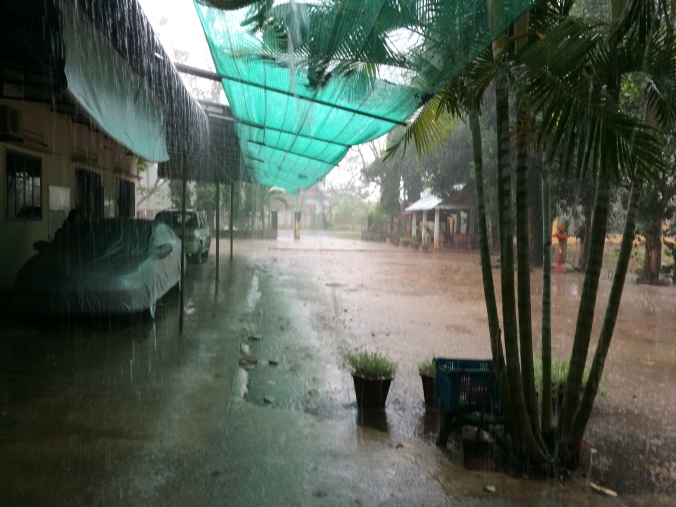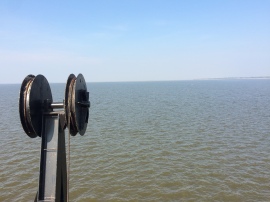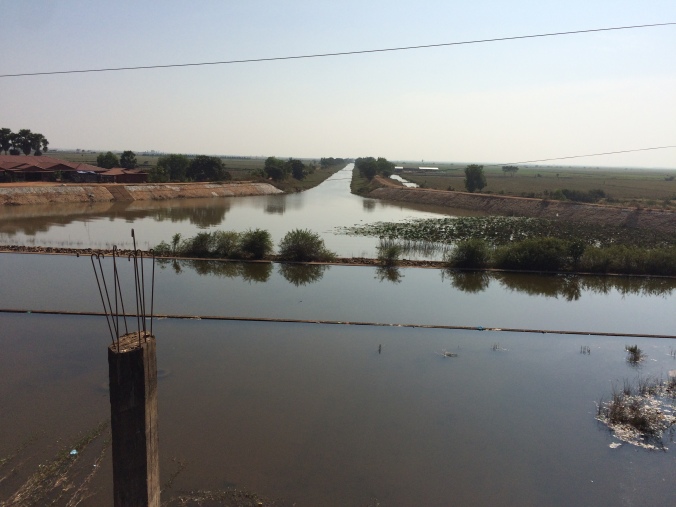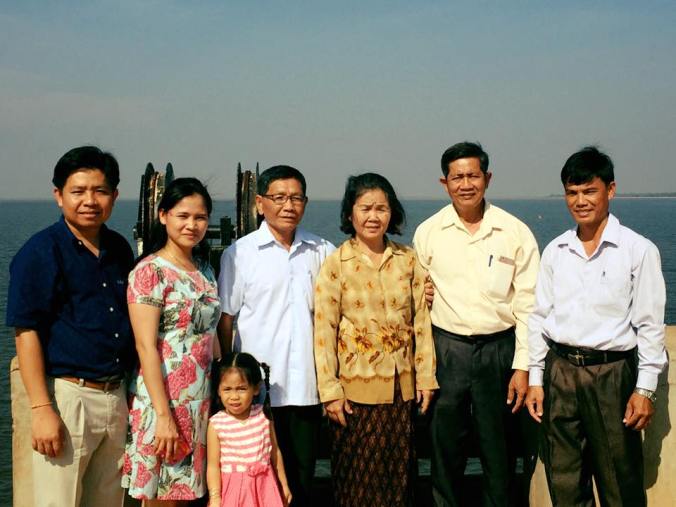Water is a huge part of life here in rural Battambang. It often takes precedence in daily conversation. Topics range from hourly weather or road conditions to more serious topics related to crop yields and drinking water. And more sobering is discussing how farmers face to lose their livelihood through flooding or drought–both of which have been increasing in frequency and severity.
But rather than talk about the many ways water is important to current Cambodian economics, culture, and life, I want to focus on a historical piece that I was privileged to hear recently.

Rain at the office! Rain in the Battambang province is talked about constantly as the province is the hub of agricultural output in the country.
I traveled with a coworker to the neighboring province of Banteay Meanchey for a weekend. We visited his entire family and they graciously welcomed me into their home and family life for the duration of my stay–they even brought me to a relative’s wedding! It was two days full of fun and new friendship. Near the end of our stay, the father of the family decided to bring me to a local reservoir called Trapaing Thmor. He simply stated that I needed to see it. I did not question his request (command) and soon enough, the entire family piled into vehicles and set out for the drive.
On our hour trip to the reservoir, we passed countless hectares of rice fields–more than my eyes could take in. Throughout the many plots of land, grid-like canal structures split plots into squares and formed large deep ditches along the road. I could tell we were getting closer to the reservoir when the canals got larger, containing more water with every passing kilometer. Before even getting to the reservoir’s shore, I was already overwhelmed by the sheer magnitude of the irrigation system it bore.

Here’s a view of the massive expanse of water held in the Trapaing Thmor reservoir. I couldn’t even see the other side!

We took time to look over the gates that allow water to flow into vast irrigation systems.

Here is the view when turning around from facing the reservoir. This major outflow brings water to many hectares across the Banteay Meanchey province
Upon reaching its shores, Trapaing Thmor stood still in its vastness. The scene was stunning. We approached its edge to take in the full view. The reservoir was so large that I failed to see the other side despite the near perfect visibility. For all I knew it could’ve been an ocean. The aunt in the family then took a step closer and began to recount her history with this body of water:
“My hands built this.”
The Khmer Rouge, in their aspiration to turn Cambodia into an agrarian utopia, forced millions into agricultural work. As countless hectares were dedicated for rice cultivation, irrigation became a major priority for the regime. Dikes, canals, dams, and reservoirs were constructed to maximize rice production.
“My hands built this.”
Massive work forces were assembled to complete numerous projects across the countryside. Her entire family was removed from their home and forced to work in various labor camps. They were first located to the Trapaing Thmor reservoir project.
“My hands built this.”
She woke up at 4am every morning to begin her work. She and her assigned partner were required to dig 3 cubic meters every 24 hours. If they, along with thousands of other workers, failed this daily objective they would be executed. They only used shovels as modern machinery was strictly forbidden. After a total of fourteen hours of work, they were permitted to sleep, often times without enough food to do so.
“My hands built this.”
Neither physicians nor medicine were available as the regime targeted educated civilians and forbade modern-day technology. Many people died from exhaustion, starvation, dehydration, and disease within the project’s two year time span. She experienced immense personal tragedy in losing her two brothers during the reservoir’s creation.
“My hands built this.”
Her opening words, as they were translated, invoked emotion I had never quite felt before. Her sentence kept replaying in my head as she paused every so often while speaking. I was struck by the simplicity of the four words and yet could hardly comprehend the immense meaning they held.

Pictured above is a coworker (far left) and parts of his immediate and extended family.
After a longer pause she suddenly reflected upon the benefits this reservoir now provides. In 2004, the failing reservoir was reconstructed to full functionality through an international funding project. It now irrigates thousands of hectares of crops across the province. Her and her family members acknowledge the reservoir’s positive contributions for many Cambodians today. It currently serves as a hallmark of modern-day ingenuity and irrigative mastery. And yet, the reservoir’s horrific and tragic conception is not forgotten as hundreds of thousands of people died during its construction.
Experiencing sadness, anger, and grief while simultaneously having the capacity to validate positive utility is a something I am not able to digest entirety. It’s beyond my cognition to recognize beneficial factors amidst so much pain and affliction. As I continue to wrestle with how to process this story, I will forever remember the emotion shared in this woman’s retelling while overlooking a juxtaposed symbol of terrible tragedy and notable agricultural achievement.
I share this story for a couple reasons: First, to bring a historical context to where I continue to live, learn, and grow. Second, to shed some light to the many stories I’ve been privileged to hear at a dinner table, underneath a shady tree, during a small party, over some coffee, or next to the shores of a body of water. Many of them describe incomprehensible hardship and pain and produce levels of emotional discomfort I have not yet known. While I possess neither the place nor capacity to share many of them, I impart this single story with permission from this woman’s family.
Lastly, it’s important to note that while this story speaks to immense tragedy in Cambodia’s complex history, it does not come close to encompassing what Cambodia was and is today. While the Khmer Rouge era did greatly influence the country, Cambodia’s essence is not overshadowed by that specific part of its past. There are so many facets of Cambodia that are overflowing with happiness and hope. It is a country of immense hospitality, resilience, and joy. I hope that I may continue to immerse myself in its many stories because despite how many I am privileged to hear, there are still countless others waiting to be heard.
In Peace,
Kurt
Reblogged this on Rice, Rice, Rice, Rice, Rice, Rice….
LikeLike